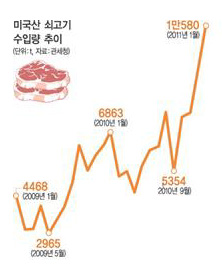
Market Information > 한국 농식품 시장뉴스
한국 농식품 시장뉴스
February 17, 2011
2011.02.17
Cabinet approved additional KORUS FTA deal [Korean: BYK]
http://www.nongmin.com/article/ar_detail.htm?ar_id=183691&subMenu=articletotal
U.S. Secretary of Treasury states, “Will put in efforts to open Korean beef market further.” [Korean: BYK]
http://www.ytn.co.kr/_ln/0104_201102170750356864
Summary: Tim Geithner, Secretary of Treasury stated that the
European parliament to vote on Korea-EU FTA U [Korean: BYK]
http://news.mk.co.kr/v3/view.php?year=2011&no=102105
Summary: The European parliament will vote on the Korea-EU FTA bill on February 17th. This agreement is likely to pass the parliament without any problems.
Report Says 10% of Rice in
http://www.hankyung.com/news/app/newsview.php?aid=2011021594291&sid=0105&nid=005<ype=1
Summary: A research by
Worries Rise over Possible Fish-flation … Not Enough Supply for Demand … Koreans are the Second Largest Consumer of Fish in the World [Korean, OSY]
http://www.hankyung.com/news/app/newsview.php?aid=2011021599091&sid=0101&nid=002<ype=1
<2/15/2011>“We Need International Cooperation to Contain Grain Prices”: Finance Minister [English, CSY]
Full text: Minister of Strategy and Finance Yoon Jeung-hyun stressed the need to harmonize internal and external economic policies and engage in closer international cooperation to keep soaring grain prices in check and ward off inflation. “The upward spiral in grain prices is a triggered by a range of complicated structural factors across the globe, including climate change and expanding demand by emerging economies,” said Minister Yoon during an economic ministers meeting on Tuesday.
“We need to counter this hike by pursuing a wide array of internal policies such as building up self-sufficiency in food, improving our distribution structure, and enlarging our emergency stockpiles. At the same time, we need to harmonize internal measures with external policies of overseas expansion, diversification of import sources, and enhanced competition through opening up, while also relying on closer international cooperation,” he continued. “The persistent cold wave and soaring price of grain are feeding insecurities to food prices. If global raw material prices continue to soar, it may weigh down
3. ECONOMIC ISSUES
Import prices hit 23-month high [English, CSY]
Economists forecast inflation will reach consumers’ pocketbooks by the spring
http://joongangdaily.joins.com/article/view.asp?aid=2932320
Summary: Most Chinese restaurants located in Jongro, central
Measures to fight FMD contamination put in place [English, CSY]
Among actions: sensors at culling sites, water surveys
http://joongangdaily.joins.com/article/view.asp?aid=2932273
Summary: Monitoring devices with automatic sensors will be installed at the disposal sites of animals culled because of foot-and-mouth disease as a part of government efforts to manage snowballing health and environmental concerns. Minister of Public Administration and Security Maeng Hyung-Kyu, Minister for Food, Agriculture, Forestry and Fisheries Yoo Jeong-bok and Minister of Environment Lee Maan-ee jointly held a press conference yesterday announcing the government’s comprehensive measures to prevent environmental damage from the mass culling of farm animals.
Additional FMD case found in central
http://english.yonhapnews.co.kr/business/2011/02/15/37/0501000000AEN20110215004900320F.HTML
Summary:
Mistaken Virus Introduction Theory Leaves Blame on Innocent Farmers; Lee government's "foot and mouth response" hopeless [English, CSY]
http://english.khan.co.kr/khan_art_view.html?artid=201102151529407&code=710100
Summary: It has emerged that the foot-and-mouth disease (FMD) virus that first broke out in Andong,
According to the report, government authorities gathered FMD samples for genetic testing from Waryong-myeon in
http://news.khan.co.kr/kh_news/khan_art_view.html?artid=201102151424111&code=920401
Summary: Volume of
http://news.khan.co.kr/kh_news/khan_art_view.html?artid=201102152136105&code=920100

Pork wholesale prices mark 6,703 won [Korean: BYK]
http://www.hankyung.com/news/app/newsview.php?aid=2011021598061
Inadequate Response to "Environmental Pollution" Caused by FMD Burials Is Deeply Worrisome [English, CSY]
http://english.khan.co.kr/khan_art_view.html?artid=201102161525307&code=790101
Summary: An investigation by Gyeonggi Province of 1844 foot-and-mouth disease (FMD) burial sites has revealed that around 17% are close to waterways, near the region of the source of the Namhan River at Paldang Water Purification Plant, or near steep gradients. In this way, mass livestock burials have taken place at sites fundamentally unsuited to the purpose. The investigation showed, moreover, that supplementary facilities were necessary due to ground subsidence in 47% of cases, inadequate waterways or reservoirs in 56% of cases, and inadequate leachate piping in 45% of areas. Inadequacy is to be found everywhere.
We can guess at the total lack of planning behind the burials, with proper guidelines far from being observed. And we cannot help but worry about environmental disasters as a consequence of this. Still more shocking is the fact that the result of investigations of 831 water samples taken from the vicinity of burial sites in Gyeonggi show 27.4% of them to be unsuitable for drinking. This gives rise to concern that water pollution may already be widespread. Despite this reality, the government and ruling party continue to insist that media reports have been exaggerated and that there is nothing to worry about.
Import Price of Coffee Beans Up 15% So Far This Year [Korean, OSY]
http://www.hankyung.com/news/app/newsview.php?aid=2011021596601&sid=010502&nid=005<ype=1
Summary: Price of coffee beans in NY Commodity Exchange Market hit a 13.6 year high on Feb. 14. The price of Arabica beans rose 2.6 percent on Feb. 14 to mark 258.6 cent per pound in the market. According to leading importers, import price of coffee beans has surged by 15 percent so far this year.
http://www.koreaherald.com/national/Detail.jsp?newsMLId=20110215000635
Summary:
The ruling and opposition party agree to open the National Assembly [Korean: BYK]
http://www.mjknews.com/news/articleView.html?idxno=42719
Summary: The ruling and opposition party agreed to hold a temporarily session from February 18th through March 12th to work on the 38 bills directly related to the livelihoods of the public that have been pending at the floor level. They will also look into creating 5 new special committees within the National Assembly and then call in Cabinet members from Feb. 24th through March 2nd to hold a Q&A session.
The information in this report was compiled by the Agricultural Trade Office (ATO) at the U.S. Embassy in Seoul, South Korea. The press summaries contained herein do NOT reflect USDA, the U.S. Embassy, or other U.S. government agency official policy or view point. U.S. food exporters can learn more about market opportunities in South Korea by reviewing ATO Seoul’s Exporter Guide and other reports available at www.fas.usda.gov by clicking on “attaché reports”.
Agricultural Trade Office, U.S. Embassy - Seoul
Tel: 82-2-6951-6848 Fax: 82-2-720-7921
Email: atoseoul@state.gov